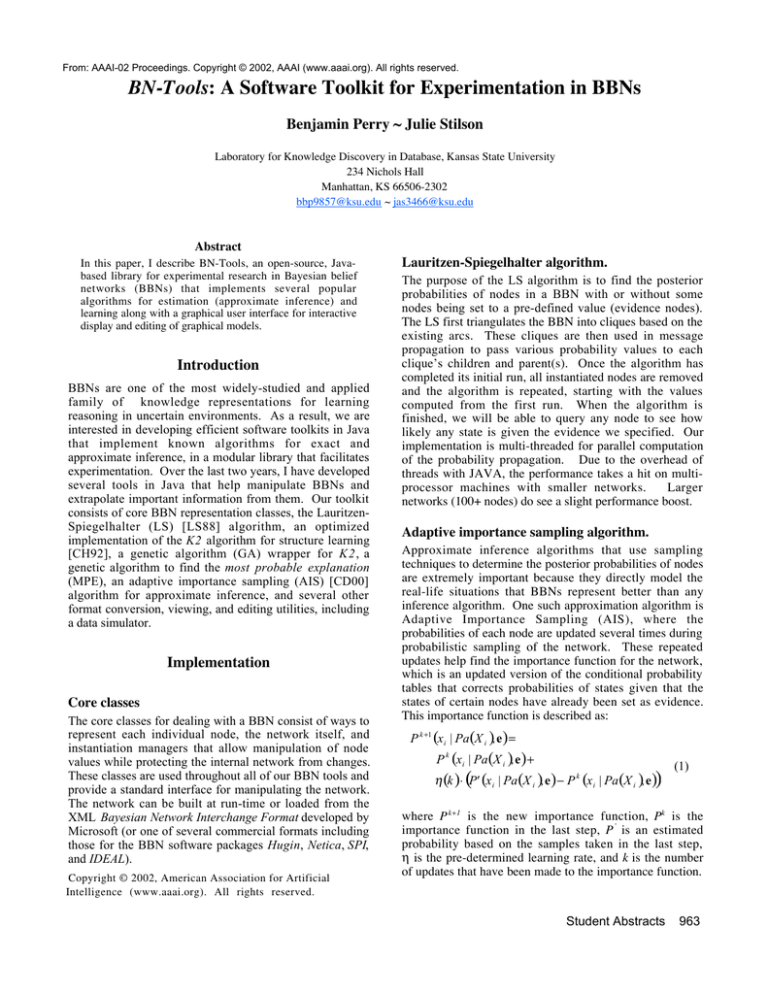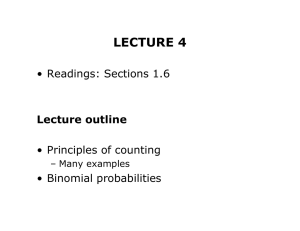
From: AAAI-02 Proceedings. Copyright © 2002, AAAI (www.aaai.org). All rights reserved.
BN-Tools: A Software Toolkit for Experimentation in BBNs
Benjamin Perry ~ Julie Stilson
Laboratory for Knowledge Discovery in Database, Kansas State University
234 Nichols Hall
Manhattan, KS 66506-2302
bbp9857@ksu.edu ~ jas3466@ksu.edu
Abstract
In this paper, I describe BN-Tools, an open-source, Javabased library for experimental research in Bayesian belief
networks (BBNs) that implements several popular
algorithms for estimation (approximate inference) and
learning along with a graphical user interface for interactive
display and editing of graphical models.
Introduction
BBNs are one of the most widely-studied and applied
family of knowledge representations for learning
reasoning in uncertain environments. As a result, we are
interested in developing efficient software toolkits in Java
that implement known algorithms for exact and
approximate inference, in a modular library that facilitates
experimentation. Over the last two years, I have developed
several tools in Java that help manipulate BBNs and
extrapolate important information from them. Our toolkit
consists of core BBN representation classes, the LauritzenSpiegelhalter (LS) [LS88] algorithm, an optimized
implementation of the K2 algorithm for structure learning
[CH92], a genetic algorithm (GA) wrapper for K2, a
genetic algorithm to find the most probable explanation
(MPE), an adaptive importance sampling (AIS) [CD00]
algorithm for approximate inference, and several other
format conversion, viewing, and editing utilities, including
a data simulator.
Implementation
Core classes
The core classes for dealing with a BBN consist of ways to
represent each individual node, the network itself, and
instantiation managers that allow manipulation of node
values while protecting the internal network from changes.
These classes are used throughout all of our BBN tools and
provide a standard interface for manipulating the network.
The network can be built at run-time or loaded from the
XML Bayesian Network Interchange Format developed by
Microsoft (or one of several commercial formats including
those for the BBN software packages Hugin, Netica, SPI,
and IDEAL).
Copyright © 2002, American Association for Artificial
Intelligence (www.aaai.org). All rights reserved.
Lauritzen-Spiegelhalter algorithm.
The purpose of the LS algorithm is to find the posterior
probabilities of nodes in a BBN with or without some
nodes being set to a pre-defined value (evidence nodes).
The LS first triangulates the BBN into cliques based on the
existing arcs. These cliques are then used in message
propagation to pass various probability values to each
clique’s children and parent(s). Once the algorithm has
completed its initial run, all instantiated nodes are removed
and the algorithm is repeated, starting with the values
computed from the first run. When the algorithm is
finished, we will be able to query any node to see how
likely any state is given the evidence we specified. Our
implementation is multi-threaded for parallel computation
of the probability propagation. Due to the overhead of
threads with JAVA, the performance takes a hit on multiprocessor machines with smaller networks.
Larger
networks (100+ nodes) do see a slight performance boost.
Adaptive importance sampling algorithm.
Approximate inference algorithms that use sampling
techniques to determine the posterior probabilities of nodes
are extremely important because they directly model the
real-life situations that BBNs represent better than any
inference algorithm. One such approximation algorithm is
Adaptive Importance Sampling (AIS), where the
probabilities of each node are updated several times during
probabilistic sampling of the network. These repeated
updates help find the importance function for the network,
which is an updated version of the conditional probability
tables that corrects probabilities of states given that the
states of certain nodes have already been set as evidence.
This importance function is described as:
P k +1 (x i | Pa(X i ), e )=
P k (x i | Pa(X i ), e )+
h (k )◊ (P' (xi | Pa(X i ), e )- P k (xi | Pa(X i ), e ))
(1)
where P k+1 is the new importance function, Pk is the
importance function in the last step, P ’ is an estimated
probability based on the samples taken in the last step,
h is the pre-determined learning rate, and k is the number
of updates that have been made to the importance function.
Student Abstracts
963
e corresponds to the pre-defined evidence you set prior to
running the network through AIS. AIS also employs two
heuristics which adapt the conditional probability tables for
unlikely evidence and extremely low probabilities by
setting the parents of unlikely evidence nodes to a uniform
distribution and by raising low probabilities to a set
threshold. These two heuristics allow the posterior
probabilities be learned properly despite very low prior
probabilities. Because the heuristic initializations and the
learned importance function allow AIS to learn the true
probabilities better than traditional sampling, we currently
use it as a fitness function for evaluating learned structures
of BBNs based on different orderings.
K2 algorithm
The K2 algorithm, developed by Cooper and Herskovits
[CH92], learns the structure of a BBN based on a
collection of training examples and a specific ordering of
the nodes. It is a greedy-search algorithm and only
considers nodes previous to the current node when building
the list of parents (thus, the order is very important). To
evaluate the output of K 2, the LS algorithm is used to
compute each node’s probabilities. We then compute rootmean-square-error (RMSE) between the probabilities
learned from the samples and the probabilities computed
by some inference method with the K2-produced network.
RMSE values closest to 0.0 are the best outcomes of the
network. We are using other means of judging the fitness
of the network as well: adaptive importance sampling and
forward sampling. Both are approximates to LS, which
will be a little less accurate, but (theoretically) much faster
for large networks.
K2 Genetic Algorithm Wrapper.
Finding the optimal ordering is NP-hard, so we have
designed a genetic algorithm to avoid exhaustively
searching all possibilities. RMSE values of the various
orderings are used as the fitness. Each chromosome in our
genetic algorithm corresponds to an ordering used in K2.
We use an order-crossover operator as well as an order
swap operator for mutation. The order-crossover’s purpose
is to maintain the order of the nodes while still swapping
out with another chromosome. There are other methods of
crossover that we will implement and test in order to
improve the performance of our genetic algorithm. We
have utilized GAJIT as the main genetic algorithm driver.
GAJIT is an elitist GA. It allows the user to specify the
cull rate (the percentage of chromosomes that make the cut
to the next generation). It also allows the user to add selfdesigned crossover and mutation operators. There are
some issues within GAJIT that we will attempt to address
in the future, most notably the crowding affect. When
selecting two chromosomes to crossover, GAJIT does not
care if a chromosome crossovers with itself. Applying the
order-crossover technique on two identical chromosomes
will yield two identical children, thus filling the population
with clones, making it difficult to get out of a local
964
Student Abstracts
optimum at times. We have developed a job-farm that
allows several computers to work on the same generation
simultaneously.
The job farm utilizes TCP to
communicate and is tolerant to lag or dropped connections.
Because we use java, we can employ several machines,
regardless of their platform. The server manages the
genetic algorithm. When a client connects, the server
sends important session parameters. Once the client is
initialized, the server simply sends an ordering to the
client. The client then runs the K2 algorithm on the
ordering, runs the specified fitness function on the learned
network, and finally sends back to the server the final
fitness. The job farm is also capable of running an
exhaustive permutation run on smaller networks. We have
begun experiments with the K2 GA wrapper by comparing
the fitness values among the gold standard Asia and Alarm
networks, the canonical ordering (or any topologically
sorted ordering), and the best ordering obtained through the
wrapper. Our initial findings are very encouraging; the GA
wrapper usually produces a network that differs from the
gold standard by a small percentage of graph errors
(missing, added, or reversed edges).
Genetic algorithm for finding the MPE.
Finding the Most Probable Explanation (MPE) of a
network is very useful, although it is NP-hard. We have
employed a GA to speed up the process by ‘stacking the
deck’ as each generation progresses. A chromosome
represents node value instantiations for all nodes in the
network. Using GAJIT [Fa00] as our main GA driver, we
have developed a Markov-blanket crossover and
chromosome (sparse state coding) rotation as a mutation
operator. The Markov blanket of radius n consists of a
node’s children, mates, parents, and the node itself,
recursively computed n times for all nodes. We use a
default radius of 1 in our GA. Although it is not
guaranteed to find the MPE, the GA performs well given a
sufficient number of generations and population size.
References
[CD00] Cheng, J. and Druzdel, M. J. 2000. AIS-BN: An
adaptive importance sampling algorithm for evidential
reasoning in large Bayesian networks. Journal of Artificial
Intelligence Research (JAIR), 13:155-188
[CH92] Cooper, G. F. and Herskovits, E, 1992.. A
Bayesian Method for the Induction of Probabilistic
Networks from Data. Machine Learning, 9(4):309-347.
[LS88] Lauritzen, S. L. and Spiegelhalter , D. J, 1988.
Local computations with probabilities on graphical
structures and their application to expert systems. Journal
of the Royal Statistical Society, Series B 50.






